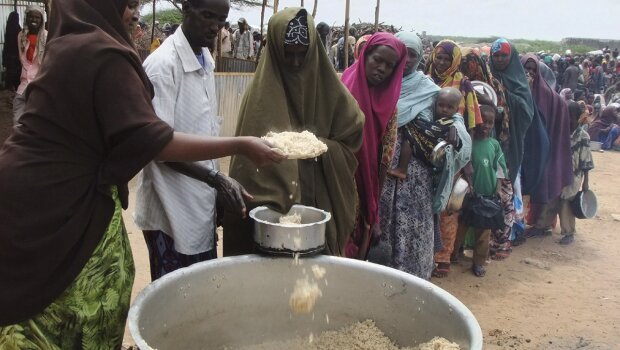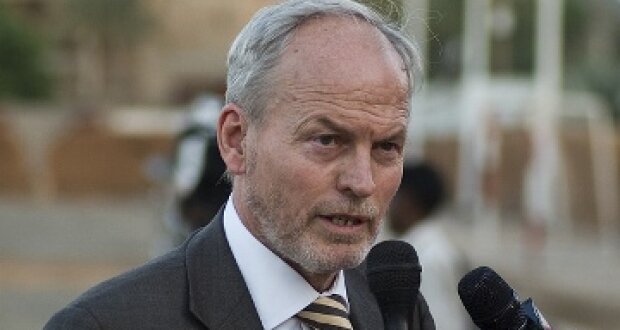 CBS News)For many, the desperate search for food, water, and medicine ends at a sprawling refugee camp in Kenya.For one retired Marine Corps general, it’s deja vu on a tragic scale. CBS News correspondent Erica Hill reports that, regardless, retired Lt. Gen. Robert Johnston is relieved he got there at all.
CBS News)For many, the desperate search for food, water, and medicine ends at a sprawling refugee camp in Kenya.For one retired Marine Corps general, it’s deja vu on a tragic scale. CBS News correspondent Erica Hill reports that, regardless, retired Lt. Gen. Robert Johnston is relieved he got there at all.
He arrived at the world’s largest refugee camp in Dadaab, Kenya, where more than 1,300 Somalis arrive each day, many trekking over a hundred miles, driven from their homes by the worst drought in 50 years, and Somalia’s second famine in 20 years
One refugee told CBS News: “I had some goats and a big farm. Four years with no rain and the farm died.”
Lt. Gen. Johnson says the situation is a kind of flashback for him. He led the international mission to feed starving Somalis – Operation Restore Hope – in the 1990′s.
“What’s happening now is almost a mirror image of what happened 19 years ago,” Johnson said.
During the 1992 famine, Somalis gratefully welcomed the help of the international community. When a U.S. Black Hawk helicopter was shot down over Mogadishu on October 3rd, 1993, American empathy turned to outrage.
Today, more than 3.5 million Somalis are at risk of starvation, but the response this time is far different.
With the world economy stretched to the brink, and the U.S. military committed to two wars, America isn’t as willing, or able, to help.
“I don’t see them wanting to go in there again, and we’re surely not going to take the lead,” Johnston said.
Further complicating relief efforts is the fact that Somalia has been without a central government for two decades.
Armed factions are constantly at war, using food to buy loyalties and guns.
In the south, where the famine is greatest, al-Shabab, a terrorist group linked to al Qaeda, is in control.
Aid workers have been threatened, even killed. In many places it’s simply too dangerous to bring aid in.
So refugees flee Somalia for Dadaab in Kenya to a camp of more than 400,000, nearly 5 times its capacity, stretching farther into the Kenyan countryside by the day.
A 34-year-old woman named Shafiro her husband and her do young boys spent weeks trying to get to the camp. She said she never would have stayed in Somalia, and believes the situation will be better at the sprawling camp.
It’s a hope she has to hold on to, along with the millions of Somalis caught somewhere between the violence at home, and the help and uncertain future across the border.
A U.S. relief official says at least 29,000 Somali children have died in a famine that, day after day, is forcing hundreds of Somalis out of their own country. CBS News)
A U.S. relief official says at least 29,000 Somali children have died in a famine that, day after day, is forcing hundreds of Somalis out of their own country.
For many, the desperate search for food, water, and medicine ends at a sprawling refugee camp in Kenya.
For one retired Marine Corps general, it’s deja vu on a tragic scale. CBS News correspondent Erica Hill reports that, regardless, retired Lt. Gen. Robert Johnston is relieved he got there at all.
He arrived at the world’s largest refugee camp in Dadaab, Kenya, where more than 1,300 Somalis arrive each day, many trekking over a hundred miles, driven from their homes by the worst drought in 50 years, and Somalia’s second famine in 20 years
One refugee told CBS News: “I had some goats and a big farm. Four years with no rain and the farm died.”
Lt. Gen. Johnson says the situation is a kind of flashback for him. He led the international mission to feed starving Somalis – Operation Restore Hope – in the 1990′s.
“What’s happening now is almost a mirror image of what happened 19 years ago,” Johnson said.
During the 1992 famine, Somalis gratefully welcomed the help of the international community. When a U.S. Black Hawk helicopter was shot down over Mogadishu on October 3rd, 1993, American empathy turned to outrage.
Today, more than 3.5 million Somalis are at risk of starvation, but the response this time is far different.
With the world economy stretched to the brink, and the U.S. military committed to two wars, America isn’t as willing, or able, to help.
“I don’t see them wanting to go in there again, and we’re surely not going to take the lead,” Johnston said.
Further complicating relief efforts is the fact that Somalia has been without a central government for two decades.
Armed factions are constantly at war, using food to buy loyalties and guns.
In the south, where the famine is greatest, al-Shabab, a terrorist group linked to al Qaeda, is in control.
Aid workers have been threatened, even killed. In many places it’s simply too dangerous to bring aid in.
So refugees flee Somalia for Dadaab in Kenya to a camp of more than 400,000, nearly 5 times its capacity, stretching farther into the Kenyan countryside by the day.
A 34-year-old woman named Shafiro her husband and her do young boys spent weeks trying to get to the camp. She said she never would have stayed in Somalia, and believes the situation will be better at the sprawling camp.
It’s a hope she has to hold on to, along with the millions of Somalis caught somewhere between the violence at home, and the help and uncertain future across the border.






